Quantification of the Aluminum Content Leached into Foods Baked Using Aluminum Foil
Abstract
:1. Introduction
2. Materials and Methods
2.1. Samples Preparation
2.2. Samples Analysis
3. Results and Discussion
3.1. Determination of Al Content in Food
3.2. Aluminum Foil Morphological Observation by SEM-EDS
3.3. General Considerations
4. Conclusions
Author Contributions
Funding
Conflicts of Interest
References
- Medana, C. Analysis of chemical contaminants in food. Toxics 2020, 8, 8–10. [Google Scholar] [CrossRef] [PubMed] [Green Version]
- Vella, C.; Attard, E. Consumption of minerals, toxic metals and hydroxymethylfurfural: Analysis of infant foods and formulae. Toxics 2019, 7, 4–11. [Google Scholar] [CrossRef] [PubMed] [Green Version]
- Fermo, P.; Beretta, G.; Facino, R.M.; Gelmini, F.; Piazzalunga, A. Ionic profile of honey as a potential indicator of botanical origin and global environmental pollution. Environ. Pollut. 2013, 178, 173–181. [Google Scholar] [CrossRef] [PubMed]
- Stahl, T.; Falk, S.; Rohrbeck, A.; Georgii, S.; Herzog, C.; Wiegand, A.; Hotz, S.; Boschek, B.; Zorn, H.; Brunn, H. Migration of aluminum from food contact materials to food—a health risk for consumers? Part I of III: Exposure to aluminum, release of aluminum, tolerable weekly intake (TWI), toxicological effects of aluminum, study design, and methods. Environ. Sci. Eur. 2017, 29, 19. [Google Scholar] [CrossRef] [PubMed]
- Stahl, T.; Falk, S.; Taschan, H.; Boschek, B.; Brunn, H. Evaluation of human exposure to aluminum from food and food contact materials. Eur. Food Res. Technol. 2018, 244, 2077–2084. [Google Scholar] [CrossRef]
- Filippini, M.; Baldisserotto, A.; Menotta, S.; Fedrizzi, G.; Rubini, S.; Gigliotti, D.; Valpiani, G.; Buzzi, R.; Manfredini, S.; Vertuani, S. Heavy metals and potential risks in edible seaweed on the market in Italy. Chemosphere 2021, 263. [Google Scholar] [CrossRef]
- Soni, M.G.; White, S.M.; Flamm, W.G.; Burdock, G.A. Safety evaluation of dietary aluminum. Regul. Toxicol. Pharmacol. 2001, 33, 66–79. [Google Scholar] [CrossRef]
- Rodriguez-Iruretagoiena, A.; Trebolazabala, J.; Martinez-Arkarazo, I.; De Diego, A.; Madariaga, J.M. Metals and metalloids in fruits of tomatoes (Solanum lycopersicum) and their cultivation soils in the Basque Country: Concentrations and accumulation trends. Food Chem. 2015, 173, 1083–1089. [Google Scholar] [CrossRef]
- Deshwal, G.K.; Panjagari, N.R. Review on metal packaging: Materials, forms, food applications, safety and recyclability. J. Food Sci. Technol. 2020, 57, 2377–2392. [Google Scholar] [CrossRef]
- Dawidowicz, A.L.; Nowakowski, P.; Typek, R.; Dybowski, M.P. Effect of food packaging material on some physicochemical properties of polyacrylate varnish layers. Food Packag. Shelf Life 2019, 21, 100370. [Google Scholar] [CrossRef]
- Klotz, K.; Weistenhöfer, W.; Neff, F.; Hartwig, A.; Van Thriel, C.; Drexler, H. The health effects of aluminum exposure. Dtsch. Arztebl. Int. 2017, 114, 653–659. [Google Scholar] [CrossRef] [PubMed] [Green Version]
- Walton, J.R. Chronic aluminum intake causes Alzheimer’s disease: Applying sir austin bradford hill’s causality criteria. J. Alzheimer’s Dis. 2014, 40, 765–838. [Google Scholar] [CrossRef] [PubMed] [Green Version]
- Feliciani, R.; Milana, M.R. Esposizione ad alluminio da materiali a contatto con alimenti: Studi, ricerche e valutazioni sperimentali. La Riv. di Sci. dell’Alimentazione 2008, 2, 5–11. [Google Scholar]
- Al Zubaidy, E.A.H.; Mohammad, F.S.; Bassioni, G. Effect of pH, salinity and temperature on aluminum cookware leaching during food preparation. Int. J. Electrochem. Sci. 2011, 6, 6424–6441. [Google Scholar]
- Antoine, J.M.R.; Fung, L.A.H.; Grant, C.N. Assessment of the potential health risks associated with the aluminium, arsenic, cadmium and lead content in selected fruits and vegetables grown in Jamaica. Toxicol. Rep. 2017, 4, 181–187. [Google Scholar] [CrossRef]
- Ministero della Salute. Sezione Sicurezza Alimentare—Cnsa (Comitato Nazionale Per La Sicurezza Alimentare) Parere N. 19 Del 3 Maggio 2017 “Esposizione del consumatore all’alluminio derivante dal contatto alimentare: Elementi di valutazione del rischio e indicazioni per un uso corretto dei materiali a contatto con gli alimenti”. Available online: http://www.salute.gov.it/imgs/C_17_pubblicazioni_2608_allegato.pdf (accessed on 10 November 2020).
- Food and Agriculture Organization of the United Nations; World Health Organization. Evaluation of certain food additives. World Health Organ. Tech. Rep. Ser. 2005, 928, 1–156. [Google Scholar]
- Aguilar, F.; Autrup, H.; Barlow, S.; Castle, L.; Crebelli, R.; Dekant, W.; Gontard, N.; Gott, D.; Grilli, S.; Leclercq, C.; et al. Safety of aluminium from dietary intake—Scientific Opinion of the Panel on Food Additives, Flavourings, Processing Aids and Food Contact Materials (AFC). EFSA J. 2008, 6, 1–34. [Google Scholar] [CrossRef]
- Merkel, S. Research project: Aluminium Release from Food Packaging. Federal Institute, BfR, 3rd meeting on 24–26, FIP FCM Network 2016, 1–18. Available online: efsa.europa.eu/en/events/event/160524-1 (accessed on 10 November 2020).
- Fekete, V.; Vandevijvere, S.; Bolle, F.; Van Loco, J. Estimation of dietary aluminum exposure of the Belgian adult population: Evaluation of contribution of food and kitchenware. Food Chem. Toxicol. 2013, 55, 602–608. [Google Scholar] [CrossRef]
- Al Juhaiman, L.A. Estimating Aluminum leaching from Aluminum cook wares in different meat extracts and milk. J. Saudi Chem. Soc. 2010, 14, 131–137. [Google Scholar] [CrossRef] [Green Version]
- Al Juhaiman, L.A. Estimating Aluminum Leaching into Meat Baked with Aluminum Foil Using Gravimetric and UV-Vis Spectrophotometric Method. Food Nutr. Sci. 2015, 6, 538–545. [Google Scholar] [CrossRef] [Green Version]
- Dordevic, D.; Buchtova, H.; Jancikova, S.; Macharackova, B.; Jarosova, M.; Vitez, T.; Kushkevych, I. Aluminum contamination of food during culinary preparation: Case study with aluminum foil and consumers’ preferences. Food Sci. Nutr. 2019, 7, 3349–3360. [Google Scholar] [CrossRef] [PubMed]
- Ranau, R.; Oehlenschläger, J.; Steinhart, H. Aluminium levels of fish fillets baked and grilled in aluminium foil. Food Chem. 2001, 73, 1–6. [Google Scholar] [CrossRef]
- Turhan, S. Aluminium contents in baked meats wrapped in aluminium foil. Meat Sci. 2006, 74, 644–647. [Google Scholar] [CrossRef] [PubMed]
- Bassioni, G.; Mohammed, F.S.; Zubaidy, E.A.; Kobrsi, I. Risk assessment of using aluminum foil in food preparation. Int. J. Electrochem. Sci. 2012, 7, 4498–4509. [Google Scholar]
- Cappelletti, G.; Ardizzone, S.; Fermo, P.; Gilardoni, S. The influence of iron content on the promotion of the zircon structure and the optical properties of pink coral pigments. J. Eur. Ceram. Soc. 2005, 25, 911–917. [Google Scholar] [CrossRef]
- Ministero della Salute. Sezione Sicurezza Alimentare—Cnsa (Comitato Nazionale Per La Sicurezza Alimentare) Parere 30 Gennaio 2019 “Esposizione del consumatore all’alluminio derivante dal contatto alimentare”: Elementi di Valutazione del Rischio e Indicazioni per un Uso Corretto dei Materiali a Contatto Con Gli Alimenti. Available online: http://www.salute.gov.it/imgs/C_17_pubblicazioni_2895_allegato.pdf (accessed on 10 November 2020).
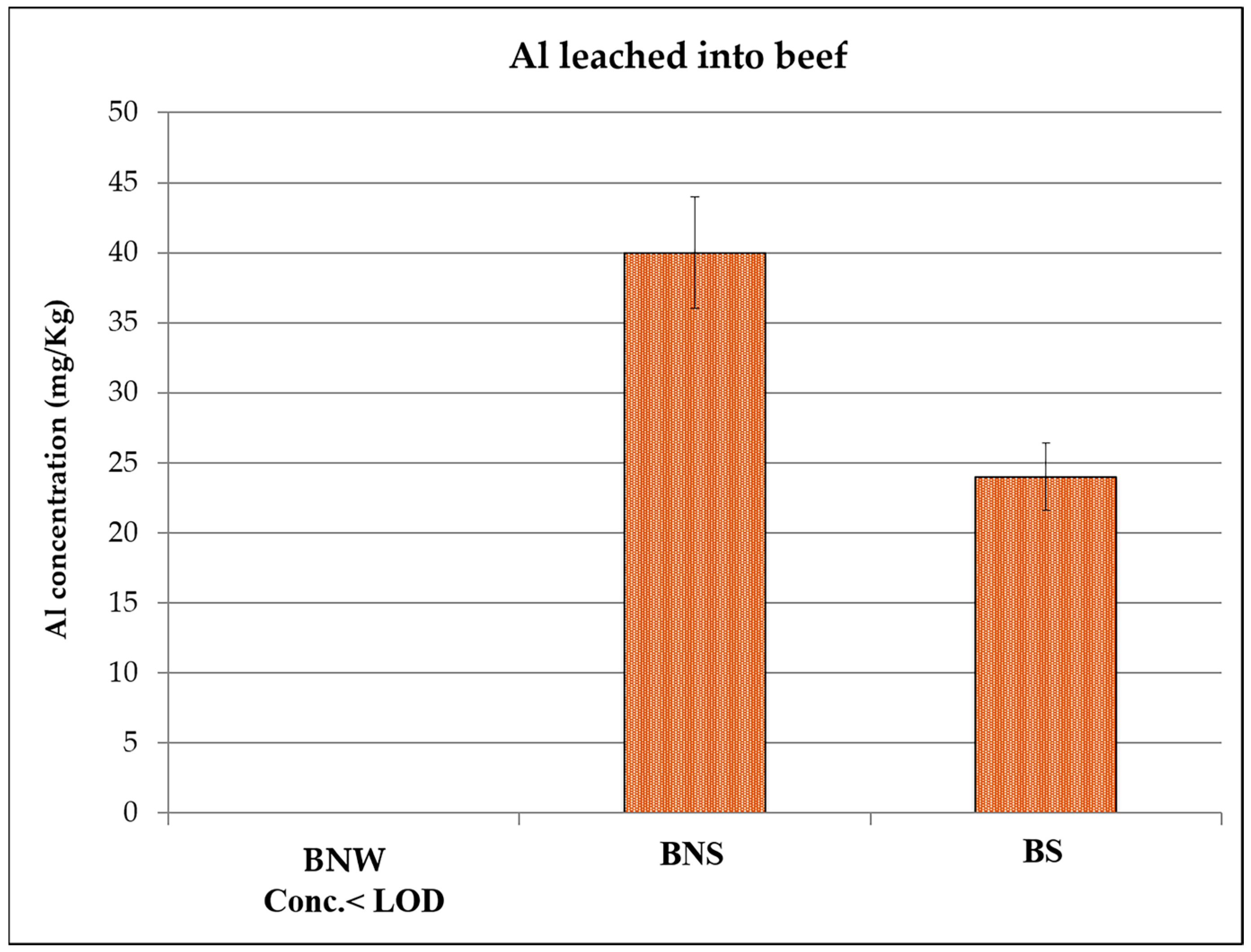
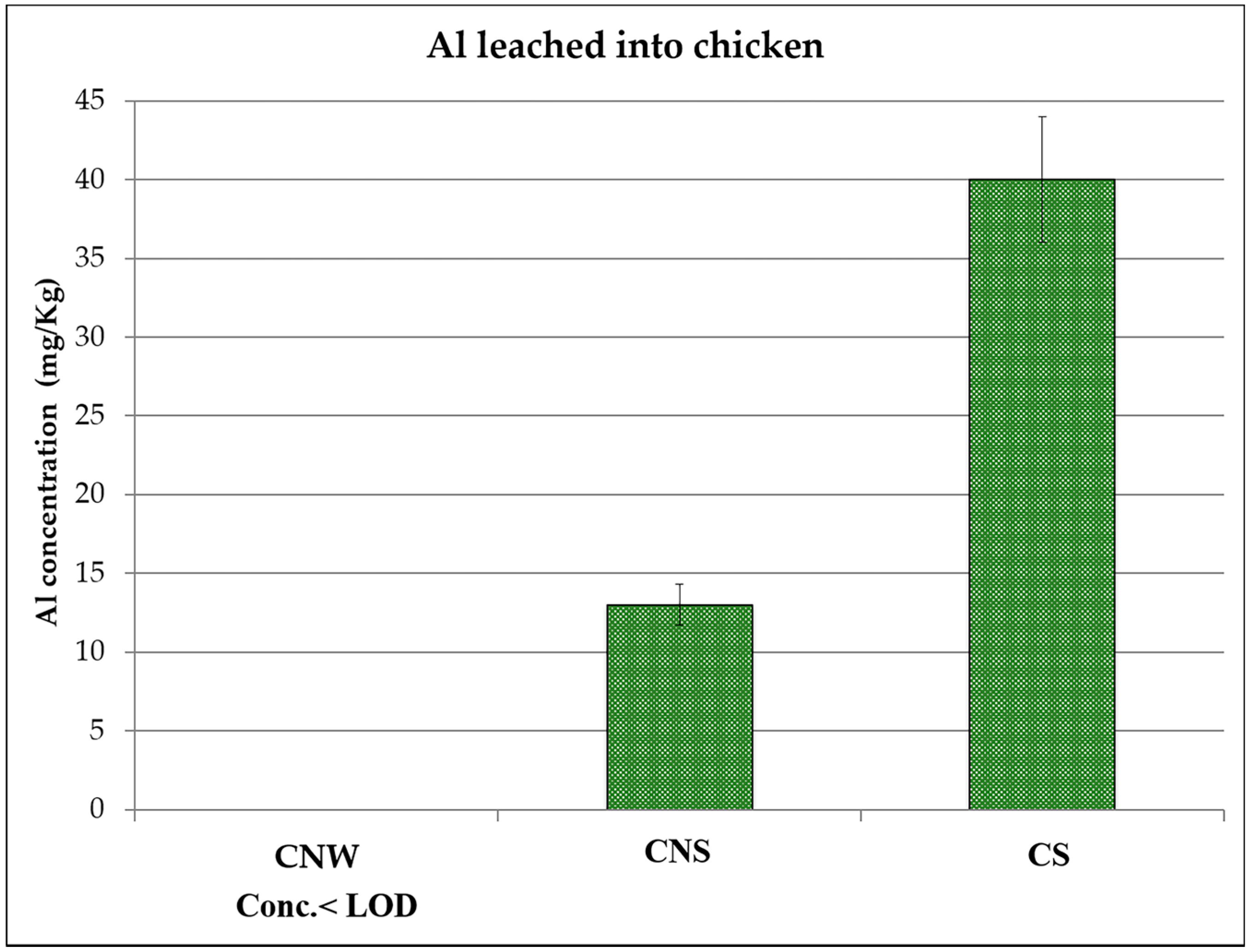
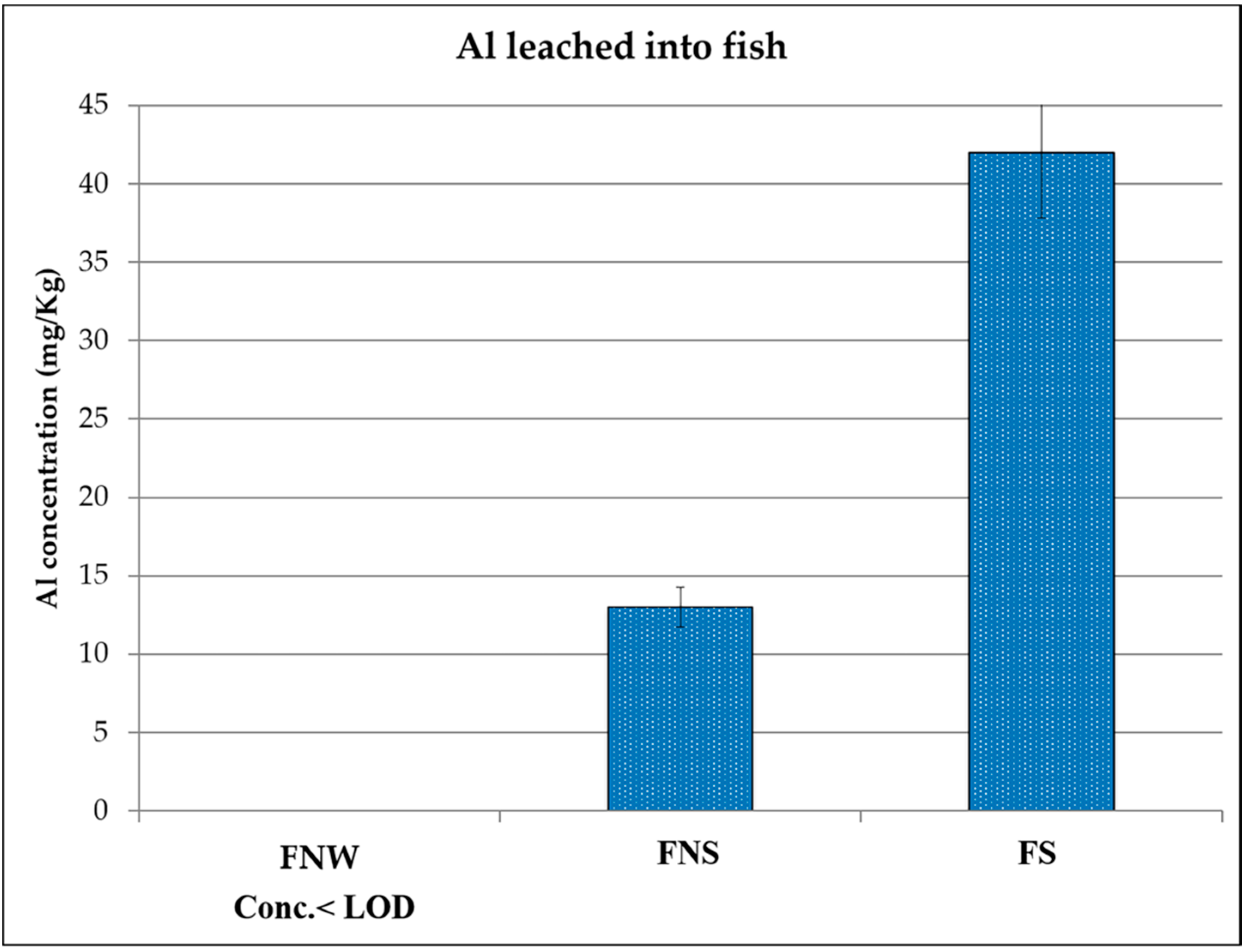
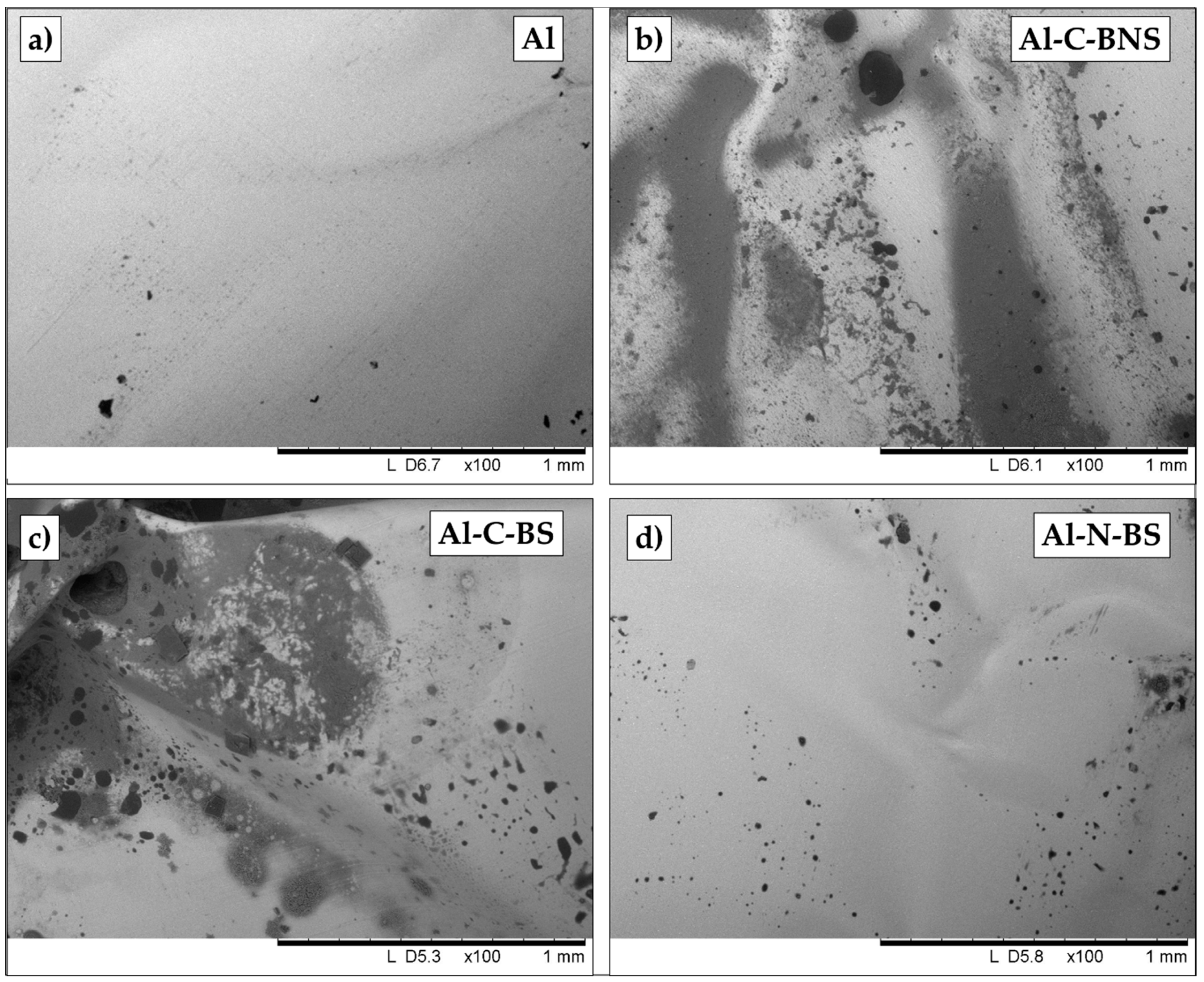
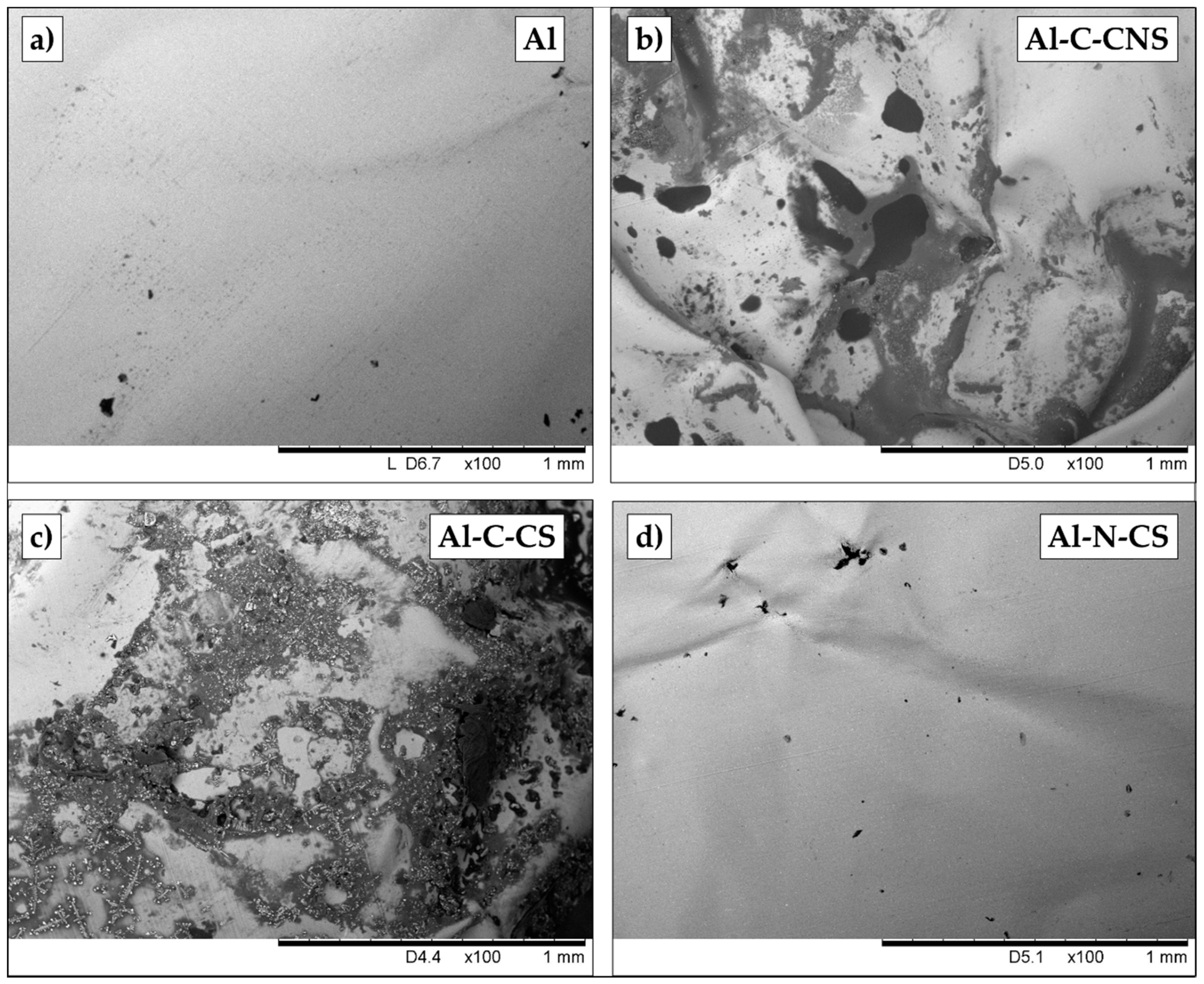
| Food Sample | Food Baked without Wrapping | Food Baked without Seasoning | Food Baked with Seasoning |
|---|---|---|---|
| Beef | BNW | BNS | BS |
| Chicken | CNW | CNS | CS |
| Fish | FNW | FNS | FS |
| Beef | Chicken |
|---|---|
| Al-C-BNS | Al-C-CNS |
| Al-C-BS | Al-C-CS |
| Al-N-BS | Al-N-CS |
Publisher’s Note: MDPI stays neutral with regard to jurisdictional claims in published maps and institutional affiliations. |
© 2020 by the authors. Licensee MDPI, Basel, Switzerland. This article is an open access article distributed under the terms and conditions of the Creative Commons Attribution (CC BY) license (http://creativecommons.org/licenses/by/4.0/).
Share and Cite
Fermo, P.; Soddu, G.; Miani, A.; Comite, V. Quantification of the Aluminum Content Leached into Foods Baked Using Aluminum Foil. Int. J. Environ. Res. Public Health 2020, 17, 8357. https://doi.org/10.3390/ijerph17228357
Fermo P, Soddu G, Miani A, Comite V. Quantification of the Aluminum Content Leached into Foods Baked Using Aluminum Foil. International Journal of Environmental Research and Public Health. 2020; 17(22):8357. https://doi.org/10.3390/ijerph17228357
Chicago/Turabian StyleFermo, Paola, Gabriele Soddu, Alessandro Miani, and Valeria Comite. 2020. "Quantification of the Aluminum Content Leached into Foods Baked Using Aluminum Foil" International Journal of Environmental Research and Public Health 17, no. 22: 8357. https://doi.org/10.3390/ijerph17228357





